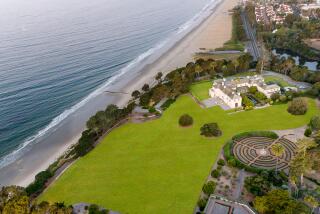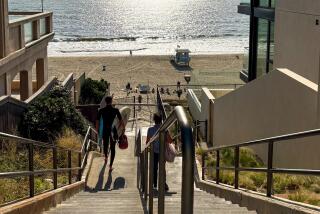Streisand Slept Here
- Share via
It isn’t Graceland. They tell you that right upfront. The folks who run the Ramirez Canyon Park, formerly the Barbra Streisand Center for Conservancy Studies, formerly the Barbra Streisand Malibu estate, are sick of the Graceland comparisons, and they want everyone to know that this is not a tourist attraction in the traditional sense. No tram ride, no gift shop (although there are a few pine cones and postcards for sale), no snack bar (although the admission price includes a very nice tea), no huge, sun-scorched parking lot.
Tours are held only Wednesdays, and carpooling is required--local regulations allow them only 40 round trips a day on the winding road to the estate. The docents are trained to avoid any discussion of Streisand’s personal life, to treat her design decisions with the utmost respect, to draw attention instead to the finer details of four of the five houses on the 22-acre property--the Bakelite sculptures in the Art Deco house, the hand-singed shingles of the Barn where Streisand actually lived, the bleached pine of Barwood, the bungalow she converted into a semi-treehouse to use as an office.
For the record:
12:00 a.m. July 25, 2002 For The Record
Los Angeles Times Thursday July 25, 2002 Home Edition Main News Part A Page 2 National Desk 15 inches; 537 words Type of Material: Correction
Streisand fund-raiser -- A Southern California Living story on July 14 about tours of Barbra Streisand’s former Malibu estate incorrectly characterized Streisand’s One Voice concert on the property as a fund-raiser for Bill Clinton. The concert had raised funds for Democratic senatorial candidates.
*
But they’re not fooling themselves: No one thinks a person would pay 30 bucks a pop to see some fairly eccentric buildings and a copse of lovely sycamores. The folks that keep the carpools necessary and the waiting lists weeks-long are here because of Barbra. Because they loooove Barbra.
“I must tell you that Barbra Streisand was a perfectionist,” says Sandee Bickart, who led a recent tour of about 35 people, mostly women, many old enough to have seen “Funny Girl” in its first Broadway run. She will mention Streisand’s perfectionism at least a dozen times in the course of an hour and a half, and every time she does, the crowd will murmur and nod their heads in rueful, fond agreement like family members discussing a headstrong but favored niece.
“She still is,” one woman answers the second time Bickart makes her observation, “she still is.” And again, that murmur of agreement and intimacy rises from beneath the leaves of those sycamores, which still mark the original path of a stream that ran through the property, a stream Streisand had moved about 100 yards so she could have a nice lawn. Such a perfectionist. Heads nod when the star’s penchant for old lace is mentioned, when her love of thrift shops is noted; if, as Bickart says, she hasn’t read even one biography, she is the only one here who hasn’t.
When, standing beside the pool of the Art Deco house, Bickart mentions that this is where Jason Gould, Barbra’s son with first husband Elliott Gould, had his bar mitzvah party, everyone smiles and sighs. “Well, it really is the perfect place,” one woman says to her friend.
Despite the obvious devotion to its former owner, Ramirez Canyon Park truly isn’t Graceland, or anything like it. Streisand’s baroque quotient doesn’t even approach an Elvis rating, and this isn’t Memphis, it’s Malibu.
The park formerly known as the Barbra Streisand Center is not so much a tourist attraction as it is an unexpected nexus of the powers that have shaped Southern California as certainly and specifically as the surf has shaped its coastline.
Celebrity, wealth, philanthropy, ecology, zoning laws, crotchety neighborhood activism, the Coastal Commission, the vagaries of fashion and good old-time voyeurism all come together on the lovely stone patio outside the Barn, which is where, according to Bickart, “Barbra liked to entertain her really close friends.”
The story of how the park came to be is told on every tour. In the beginning there were seven acres at the end of Ramirez Canyon Road and the Barn in which lived Jon Peters, hairstylist. Streisand moved in with Peters in 1974 and over the years the two converted a nearby stable into the Peach House and purchased three other adjacent properties--15 additional acres in all. By the late ‘80s, Peters and Streisand had split, and Streisand put the property on the market for a cool $19 mil. No sale.
In 1993, she decided to donate it to the Santa Monica Mountains Conservancy and take a $15-million tax write-off. But she made no endowment for its upkeep, and the property costs about $160,000 a year to maintain. So the conservancy began thinking of it as a place various green groups could rent out for conferences and even retreats.
Meanwhile, they offered tours and rented the grounds out for weddings, photo shoots, even movies.
The neighbors complained. Loudly, bitterly and in court. Ramirez Canyon Road is narrow and winding, not intended for catering trucks and busloads of gawking out-of-towners. The people who live along the road obviously value privacy. Enter the California Coastal Commission.
Conferences were out, retreats were out, anything that required more than 40 vehicles per day to the park or a vehicle larger than a 15-seat passenger van was out. The conservancy is now required to do community outreach, which it says it was doing already--groups of elderly people and disadvantaged and disabled children are brought to the park for special tours and events. There is still an unresolved legal case involving zoning and the city of Malibu.
At some point during the litigious years, Streisand took her name off the establishment, which puts the conservancy in an odd and difficult position. The star’s name is the only thing it has going for it in terms of visitor draw, but, according to Marsha Feldman, supervisor of events and operations at the park, the conservancy doesn’t think it’s appropriate to advertise the park as the former Barbra Streisand estate.
“We want to respect people’s privacy,” she says, adding that although people may come because of the name, they soon find themselves captivated by the beauty of the place. “People don’t want to leave,” she says. “It’s just so beautiful and relaxing here.”
“Isn’t it lovely?” Bickart says often during the tour. “Tell all your friends.”
The park is lovely, how could it not be, set as it is, as Bickart points out, in a truly Mediterranean climate. Streisand spruced it up even further with hundreds of nonnative trees, including a few gorgeous redwoods and shrubs. Yes, the Barn seems faux-rustic and oddly laid out, but it was the ‘70s, after all, and many style decisions made during that decade do not stand up to post-millennial scrutiny. Yes, there is something unnerving about the fact that the Art Deco house was built solely to house Streisand’s Art Deco collection--even she apparently found it too emotionally cold to live in. There is something poignant too about the fact that in this five-home compound there is only one guest bedroom--aside from the Barn and the caretaker’s house, the rest of the houses were used as offices or for entertaining.
But what provides the electricity of the tour is the knowledge that this is not Graceland or Hearst Castle or any number of other famous home tours. Nothing here is excessively excessive, and the woman is still alive, after all, still living somewhere in Malibu.
So the feeling is more like a hybrid between the Pasadena homes tour and a very high-end open house party. Add to that the palpably sincere gratitude the conservancy staff seems to feel for Streisand and one finds it almost impossible to muster the half-envious ridicule that often fuels the voyeurism associated with these kinds of tours, even when confronted with a 4-foot-high, apricot onyx fireplace.
Instead, one finds oneself listening to Bickart’s thumbnail histories of the Chumash Indians, Malibu and Bakelite, lulled by the murmur of the rerouted brook, picturing 500 luminaries gathering on the meadow (constructed from the dirt removed during the terracing of her orchard) for the One Voice concert Streisand gave to raise money for then presidential nominee Bill Clinton.
It is indeed an oasis, tucked into the velvety folds of the Santa Monica Mountains, and how else would most of us ever get to see such a place? To imagine what it would be like to live in a place like this, to be a person like that, a movie star, an icon, someone who bought the house next door by handing the new owner a check for double what she just paid, someone who replanted redwoods and rerouted a stream, someone who built a whole house just for her art. Someone who then turned around and gave the whole kit and caboodle away.
More to Read
Sign up for The Wild
We’ll help you find the best places to hike, bike and run, as well as the perfect silent spots for meditation and yoga.
You may occasionally receive promotional content from the Los Angeles Times.







